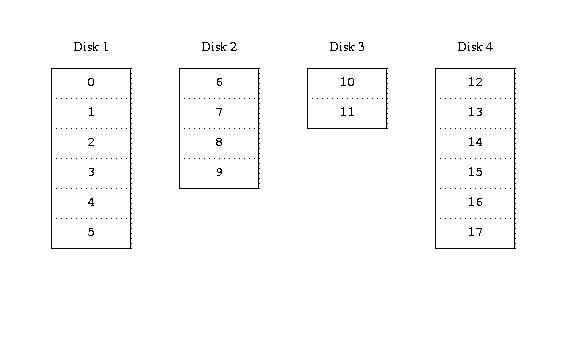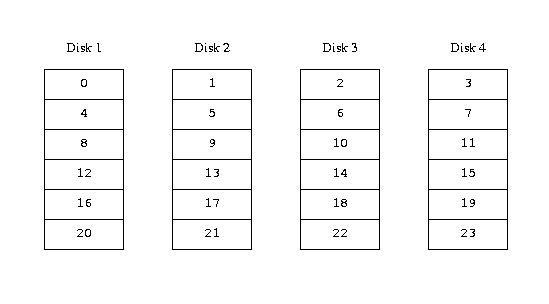Previous sections
IntroductionThe problems
Various solutions to these problems have been proposed and implemented:Disks are too small
The ufs file system can theoretically span more than a petabyte (2**50 or 1,125,899,906,842,624 bytes) of storage, but no current disk drive comes close to this size. Although this problem is not as acute as it was ten years ago, there is a simple solution: the disk driver can create an abstract device which stores its data on a number of disks. A number of such implementations exist, though none appear to have become mainstream.Access bottlenecks
Modern systems frequently need to access data in a highly concurrent manner. For example, wcarchive.cdrom.com maintains up to 3,600 concurrent FTP sessions and has a 100 Mbit/s connection to the outside world, corresponding to about 12 MB/s.Current disk drives can transfer data sequentially at up to 30 MB/s, but this value is of little importance in an environment where many independent processes access a drive, where they may achieve only a fraction of these values. In such cases it's more interesting to view the problem from the viewpoint of the disk subsystem: the important parameter is the load that a transfer places on the subsystem, in other words the time for which a transfer occupies the drives involved in the transfer.
In any disk transfer, the drive must first position the heads, wait for the first sector to pass under the read head, and then perform the transfer. These actions can be considered to be atomic: it doesn't make any sense to interrupt them.
Consider a typical transfer of about 10 kB: the current generation of high-performance disks can position the heads in an average of 6 ms. The fastest drives spin at 10,000 rpm, so the average rotational latency (half a revolution) is 3 ms. At 30 MB/s, the transfer itself takes about 350 Ás, almost nothing compared to the positioning time. In such a case, the effective transfer rate drops to a little over 1 MB/s and is clearly highly dependent on the transfer size.
The traditional and obvious solution to this bottleneck is ``more spindles'': rather than using one large disk, it uses several smaller disks with the same aggregate storage space. Each disk is capable of positioning and transferring independently, so the effective throughput increases by a factor close to the number of disks used.
The exact throughput improvement is, of course, smaller than the number of disks involved: although each drive is capable of transferring in parallel, there is no way to ensure that the requests are evenly distributed across the drives. Inevitably the load on one drive will be higher than on another.
The evenness of the load on the disks is strongly dependent on the way the data is shared across the drives. In the following discussion, it's convenient to think of the disk storage as a large number of data sectors which are addressable by number, rather like the pages in a book. The most obvious method is to divide the virtual disk into groups of consecutive sectors the size of the individual physical disks and store them in this manner, rather like taking a large book and tearing it into smaller sections. This method is called concatenation and has the advantage that the disks do not need to have any specific size relationships. It works well when the access to the virtual disk is spread evenly about its address space. When access is concentrated on a smaller area, the improvement is less marked. The following figure illustrates the sequence in which storage units are allocated in a concatenated organization.

Concatenated organization

Striped organization
Data integrity
The final problem with current disks is that they are unreliable. Although disk drive reliability has increased tremendously over the last few years, they are still the most likely core component of a server to fail. When they do, the results can be catastrophic: replacing a failed disk drive and restoring data to it can take days.The traditional way to approach this problem has been mirroring, keeping two copies of the data on different physical hardware. Since the advent of the RAID levels, this technique has also been called RAID level 1 or RAID-1. Any write to the volume writes to both locations; a read can be satisfied from either, so if one drive fails, the data is still available on the other drive.
Mirroring has two problems:
- The price. It requires twice as much disk storage as a non-redundant solution.
- The performance impact. Writes must be performed to both drives, so they take up twice the bandwidth of a non-mirrored volume. Reads do not suffer from a performance penalty: it even looks as if they are faster. This issue will be discussed below.
An alternative solution is parity, implemented in the RAID levels 2, 3, 4 and 5. Of these, RAID-5 is the most interesting. As implemented in Vinum, it is a variant on a striped organization which dedicates one block of each stripe to parity of the other blocks: As implemented by Vinum, a RAID-5 plex is similar to a striped plex, except that it implements RAID-5 by including a parity block in each stripe. As required by RAID-5, the location of this parity block changes from one stripe to the next. The numbers in the data blocks indicate the relative block numbers.

RAID-5 organization
Following sections
Current implementationsHow Vinum addresses the Three Problems
The big picture
Some examples
Increased resilience: RAID-5
Object naming
Startup
Performance issues
The implementation
Driver structure
Availability
Future directions
References